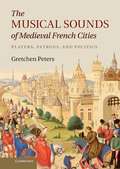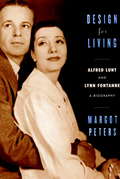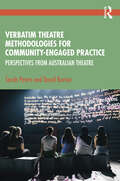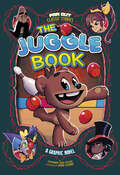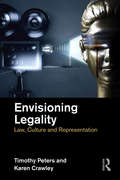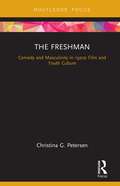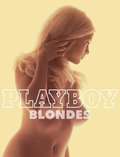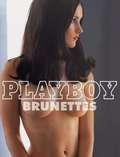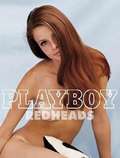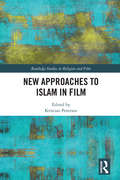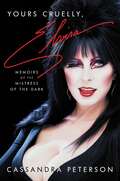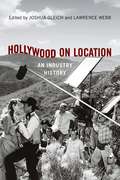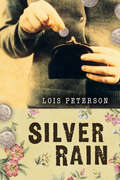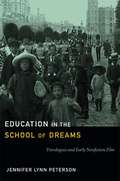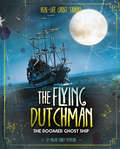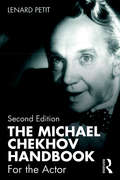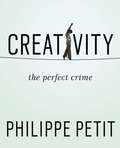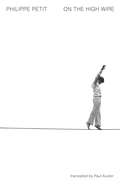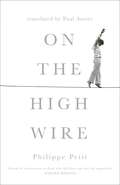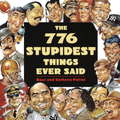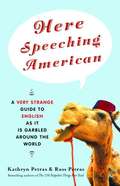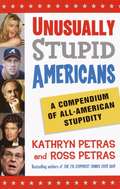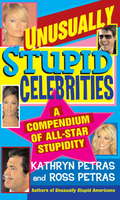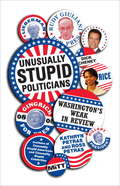- Table View
- List View
The Musical Sounds of Medieval French Cities: Players, Patrons, and Politics
by Gretchen PetersDrawing upon hundreds of newly uncovered archival records, Gretchen Peters reconstructs the music of everyday life in over twenty cities in late medieval France. Through the comparative study of these cities' political and musical histories, the book establishes that the degree to which a city achieved civic authority and independence determined the nature and use of music within the urban setting. The world of urban minstrels beyond civic patronage is explored through the use of diverse records; their livelihood depended upon seeking out and securing a variety of engagements from confraternities to bathhouses. Minstrels engaged in complex professional relationships on a broad level, as with guilds and minstrel schools, and on an individual level, as with partnerships and apprenticeships. The study investigates how minstrels fared economically and socially, recognizing the diversity within this body of musicians in the Middle Ages from itinerant outcasts to wealthy and respected town musicians.
Design for Living: Alfred Lunt and Lynn Fontanne
by Margot PetersFrom the much-admired biographer of Charlotte Brontë, Mrs. Patrick Campbell, and the Barrymores ("Margot Peters is surely now . . . our foremost historian of stage make-believe"--Leon Edel), a new biography of the most famous English-speaking acting team of the twentieth century. Individually, they were recognized as extraordinary actors, each one a star celebrated, imitated, sought after. Together, they were legend. The Lunts. A name to conjure with. Alfred Lunt and Lynn Fontanne worked together so imaginatively, so seamlessly onstage that they seemed to fuse into one person. Offstage, they brawled so famously and raucously over every detail of every performance that they inspired the musical Kiss Me, Kate. At home on Broadway, in London's West End, touring the United States and Great Britain, and even playing "the foxhole circuit" of World War II, the Lunts stunned, moved, and mystified audiences for more than four decades. They were considered to be a rarefied taste, but when they toured Texas in the 1930s, the audience threw cowboy hats onto the stage. Their private life was equally fascinating, as unusual as the one they led in public. Friends like the critic Alexander Woollcott (whom Edna Ferber once described as "the little New Jersey Nero who thinks his pinafore is a toga"), Noël Coward, Laurette Taylor, and Sidney Greenstreet received lifelong loyalty and hospitality. Ten Chimneys, their country home in Genesee Depot, Wisconsin, "is to performers what the Vatican is to Catholics," Carol Channing once said. "The Lunts are where we all spring from. " In this new biography, Margot Peters catches the magic of Lunt and Fontanne--their period, their work, their intimacy and its contradictions--with candor, delicacy, intelligence, and wit. She writes about their personal and creative choices as deftly as she captures their world, from their meeting (backstage, naturally)--when Fontanne was a young actress in the first flush of stardom and Lunt a lanky midwesterner who came in the stage door, bowed to her elaborately, lost his balance, and fell down the stairs--and the early days when an unknown and very hungry Noël Coward lived in a swank hotel in a room the size of a closet and cadged meals at their table to the telegram the famous couple once sent to a movie mogul, turning down a studio contract worth a fortune ("We can be bought, my dear Mr. Laemmle, but we can't be bored"). We follow the Lunts through triumphs in plays such as The Guardsman, The Taming of the Shrew, and Design for Living; through friendships and feuds; through the intricate way they worked with such playwrights and directors as S. N. Behrman, Robert Sherwood, Giraudoux, Dürrenmatt, Peter Brook, and with each other. Margot Peters captures the gallantry of two remarkably gifted people who lived for their art and for each other. Alfred Lunt and Lynn Fontanne were once described as an "amazing duet of intelligence and gaiety. " Margot Peters re-creates the fun and the fireworks. From the Hardcover edition.
Verbatim Theatre Methodologies for Community Engaged Practice: Perspectives from Australian Theatre
by Sarah Peters David BurtonVerbatim Theatre Methodologies for Community-Engaged Practice offers a framework for developing original community-engaged productions using a range of verbatim theatre approaches. This book's methodologies offer an approach to community-engaged productions that fosters collaborative artistry, ethically nuanced practice, and social intentionality. Through research-based discussion, case study analysis, and exercises, it provides a historical context for verbatim theatre; outlines the ethics and methods for community immersion that form the foundation of community-engaged best practice; explores the value of interviews and how to go about them; provides clear pathways for translating gathered data into an artistic product; and offers rehearsal room strategies for playwrights, producers, directors, and actors in managing the specific context of the verbatim theatre form. Based on diverse, real-world practice that spans regional, metropolitan, large-scale, micro, independent, commercial, and curriculum-based work, this is a practical and accessible guide for undergraduates, artists, and researchers alike.
The Juggle Book (Far Out Classic Stories)
by Stephanie True PetersWith winter coming, orphaned bear cub Glee is looking for a place to nap. He finally finds a cozy corner in an empty railroad car. Glee is rudely awakened and discovers that he has taken a ride on a traveling circus train! The performers who find him adore him and try to find an act for him. That is the only way the ringleader will let him stay. Will Glee be able to find his talent in time, or will he end up back out in the cold?
Envisioning Legality: Law, Culture and Representation
by Timothy Peters Karen CrawleyEnvisioning Legality: Law, Culture and Representation is a path-breaking collection of some of the world’s leading cultural legal scholars addressing issues of law, representation and the image. Law is constituted in and through the representations that hold us in their thrall, and this book focuses on the ways in which cultural legal representations not only reflect or contribute to an understanding of law, but constitute the very fabric of legality itself. As such, each of these ‘readings’ of cultural texts takes seriously the cultural as a mode of envisioning, constituting and critiquing the law. And the theoretically sophisticated approaches utilised here encompass more than simply an engagement with ‘harmless entertainment’. Rather they enact and undertake specific political and critical engagements with timely issues, such as: the redressing of past wrongs; recognising and combatting structural injustices; and orienting our political communities in relation to uncertain futures. Envisioning Legality thereby presents a cultural legal studies that provides the means for engaging in robust, sustained and in-depth encounters with the nature and role of law in a global, mediated world.
The Freshman: Comedy and Masculinity in 1920s Film and Youth Culture (Cinema and Youth Cultures)
by Christina G. PetersenBefore the advent of the teenager in the 1940s and the teenpic in the 1950s, The Freshman (Taylor and Newmeyer, 1925) represented 1920s college youth culture as an exclusive world of leisure to a mass audience. Starring popular slapstick comedian Harold Lloyd, The Freshman was a hit with audiences for its parody of contemporary conceptions of university life as an orgy of proms and football games, becoming the highest grossing comedy feature of the silent era. This book examines The Freshman from a number of perspectives, with a focus on the social, economic, and political context that led to the rise of campus culture as a distinct subculture and popular mass culture in 1920s America; Lloyd’s use of slapstick to represent an embodied, youthful middle-class masculinity; and the film’s self-reflexive exploration of the conflict between individuality and conformity as an early entry in the youth film genre.
Playboy: Blondes
by James R. PetersenFrom Playboy's classic archives comes a trilogy of mini volumes, each devoted to a certain hair color destined to quicken a man's pulse. Blonde? Brunette? Redhead? In the fifties, sixties, and seventies, it seemed like all the Playboy models, not just blondes, had more fun. Building sandcastles in the buff, romping on tiger skin rugs, or starting pillow fights, beauties of every tress are captured in these timeless color photographs. Playboy contributing editor James R. Petersen introduces each book with a heartfelt text, and witty quotes are sprinkled throughout. At once evocative and whimsical, this handsome collection is a perfect gift for a gentleman--whether he prefers a blonde, marries a brunette, or has always had a thing for a redhead.
Playboy: Brunettes
by James R. PetersenFrom Playboy's classic archives comes a trilogy of mini volumes, each devoted to a certain hair color destined to quicken a man's pulse. Blonde? Brunette? Redhead? In the fifties, sixties, and seventies, it seemed like all the Playboy models, not just blondes, had more fun. Building sandcastles in the buff, romping on tiger skin rugs, or starting pillow fights, beauties of every tress are captured in these timeless color photographs. Playboy contributing editor James R. Petersen introduces each book with a heartfelt text, and witty quotes are sprinkled throughout. At once evocative and whimsical, this handsome collection is a perfect gift for a gentleman--whether he prefers a blonde, marries a brunette, or has always had a thing for a redhead.
Playboy: Redheads
by James R. PetersenFrom Playboy's classic archives comes a trilogy of mini volumes, each devoted to a certain hair color destined to quicken a man's pulse. Blonde? Brunette? Redhead? In the fifties, sixties, and seventies, it seemed like all the Playboy models, not just blondes, had more fun. Building sandcastles in the buff, romping on tiger skin rugs, or starting pillow fights, beauties of every tress are captured in these timeless color photographs. Playboy contributing editor James R. Petersen introduces each book with a heartfelt text, and witty quotes are sprinkled throughout. At once evocative and whimsical, this handsome collection is a perfect gift for a gentleman--whether he prefers a blonde, marries a brunette, or has always had a thing for a redhead.
New Approaches to Islam in Film (Routledge Studies in Religion and Film)
by Kristian PetersenMany global film industries fail in expanding the role of Muslims on screen. Too often they produce a dichotomy between "good" and "bad" Muslims, limiting the narrative domain to issues of national security, war, and terrorism. Naturally, much of the previous scholarship on Muslims in film focused on stereotypes and the politics of representation. This collection of essays, from an international panel of contributors, significantly expands the boundaries of discussion around Muslims in film, asking new questions of the archive and magnifying analyses of particular cultural productions. The volume includes the exploration of regional cinemas, detailed analysis of auteurs and individual films, comparison across global cinema, and new explorations that have not yet entered the conversation. The interdisciplinary collection provides an examination of the multiple roles Islam plays in film and the various ways Muslims are depicted. Across the chapters, key intersecting themes arise that push the limits of how we currently approach issues of Muslims in cinema and ventures to lead us in new directions for future scholarship. This book adds new depth to the matrix of previous scholarship by revisiting methodological structures and sources, as well as exploring new visual geographies, transnational circuits, and approaches. It reframes the presiding scholarly conventions in five novel trajectories: considering new sources, exploring new communities, probing new perspectives, charting new theoretical directions, and offering new ways of understanding conflict in cinema. As such, it will be of great use to scholars working in Islamic Studies, Film Studies, Religious Studies, and Media.
Yours Cruelly, Elvira: Memoirs of the Mistress of the Dark
by Cassandra PetersonThe woman behind the icon known as Elvira, Mistress of the Dark, the undisputed Queen of Halloween, reveals her full story, filled with intimate bombshells, told by the bombshell herself. On Good Friday in 1953, at only 18 months old, 25 miles from the nearest hospital in Manhattan, Kansas, Cassandra Peterson reached for a pot on the stove and doused herself in boiling water. Third-degree burns covered 35% of her body, and the prognosis wasn't good. But she survived. Burned and scarred, the impact stayed with her and became an obstacle she was determined to overcome. Feeling like a misfit led to her love of horror. While her sisters played with Barbie dolls, Cassandra built model kits of Frankenstein and Dracula, and idolized Vincent Price. <P><P>Due to a complicated relationship with her mother, Cassandra left home at 14, and by age 17 she was performing at the famed Dunes Hotel in Las Vegas. Run-ins with the likes of Frank Sinatra, Sammy Davis Jr., and Tom Jones helped her grow up fast. Then a chance encounter with her idol Elvis Presley, changed the course of her life forever, and led her to Europe where she worked in film and traveled Italy as lead singer of an Italian pop band. She eventually made her way to Los Angeles, where she joined the famed comedy improv group, The Groundlings, and worked alongside Phil Hartman and Paul "Pee-wee" Reubens, honing her comedic skills. <P><P>Nearing age 30, a struggling actress considered past her prime, she auditioned at local LA channel KHJ as hostess for the late night vintage horror movies. Cassandra improvised, made the role her own, and got the job on the spot. Yours Cruelly, Elvira is an unforgettably wild memoir. Cassandra doesn't shy away from revealing exactly who she is and how she overcame seemingly insurmountable odds. Always original and sometimes outrageous, her story is loaded with twists, travails, revelry, and downright shocking experiences. It is the candid, often funny, and sometimes heart-breaking tale of a Midwest farm girl's long strange trip to become the world's sexiest, sassiest Halloween icon. <P><P><b>A New York Times Best Seller</b>
Epic Encounters in the Animal Kingdom: Epic Encounters In The Animal Kingdom (Brave Wilderness #2)
by Coyote Petersonp.p1 {margin: 0.0px 0.0px 0.0px 0.0px; font: 15.0px Calibri; -webkit-text-stroke: #000000} span.s1 {font-kerning: none} Wildlife expert and YouTube phenomenon, Coyote Peterson, is back with the sequel to the bestselling Brave Adventures: Wild Animals in a Wild World. Once again, Coyote and his crew voyage to new environments and encounter an even more eclectic ensemble of the planets' animals. From a slimy octopus to elusive tree climbing lizards to nomadic wolverines--this book promises to be another fast-paced, wild experience. Coyote will take readers for a hike through a snake infested island, kayak the ocean to discover a migrating pod of killer whales, and track a pride of lions across the South African savanna! You don't want to miss these never-before-told brave adventures, guaranteed to be a hit with Coyote's 13 million fans as well as animal lovers around the world! Includes over one hundred hand-drawn, black-and-white illustrations throughout. p.p1 {margin: 0.0px 0.0px 0.0px 0.0px; font: 10.0px Times}
Hollywood on Location: An Industry History
by Jennifer Lynn Peterson Sheri Chinen Biesen Noelle Griffis Daniel Steinhart Julian StringerLocation shooting has always been a vital counterpart to soundstage production, and at times, the primary form of Hollywood filmmaking. But until now, the industrial and artistic development of this production practice has been scattered across the margins of larger American film histories. Hollywood on Location is the first comprehensive history of location shooting in the American film industry, showing how this mode of filmmaking changed Hollywood business practices, production strategies, and visual style from the silent era to the present. The contributors explore how location filmmaking supplemented and later, supplanted production on the studio lots. Drawing on archival research and in-depth case studies, the seven contributors show how location shooting expanded the geography of American film production, from city streets and rural landscapes to far-flung territories overseas, invoking a new set of creative, financial, technical, and logistical challenges. Whereas studio filmmaking sought to recreate nature, location shooting sought to master it, finding new production values and production economies that reshaped Hollywood’s modus operandi.
Silver Rain
by Lois PetersonAbandoned by her father during the Depression, eleven-year-old Elsie lives in the garage behind her old house with her mother, grandmother Nan and out-of-work uncle. Elsie's friend Scoop accompanies her as she searches for her father in the city, encountering unfriendly hobos, food lines and shantytowns. After both her uncle and her mother disappear on mysterious errands, Elsie and Scoop eventually discover them competing in a dance marathon. Persuading them to abandon the contest, Elsie and Scoop lead the exhausted dancers home, where Nan has news of Elsie's father and his impending return to the family.
Education in the School of Dreams: Travelogues and Early Nonfiction Film
by Peterson Jennifer LynnIn the earliest years of cinema, travelogues were a staple of variety film programs in commercial motion picture theaters. These short films, also known as "scenics," depicted tourist destinations and exotic landscapes otherwise inaccessible to most viewers. Scenics were so popular that they were briefly touted as the future of film. But despite their pervasiveness during the early twentieth century, travelogues have been overlooked by film historians and critics. In Education in the School of Dreams, Jennifer Lynn Peterson recovers this lost archive. Through innovative readings of travelogues and other nonfiction films exhibited in the United States between 1907 and 1915, she offers fresh insights into the aesthetic and commercial history of early cinema and provides a new perspective on the intersection of American culture, imperialism, and modernity in the nickelodeon era. Peterson describes the travelogue's characteristic form and style and demonstrates how imperialist ideologies were realized and reshaped through the moving image. She argues that although educational films were intended to legitimate filmgoing for middle-class audiences, travelogues were not simply vehicles for elite ideology. As a form of instructive entertainment, these technological moving landscapes were both formulaic and also wondrous and dreamlike. Considering issues of spectatorship and affect, Peterson argues that scenics produced and disrupted viewers' complacency about their own place in the world.
The Flying Dutchman: The Doomed Ghost Ship (Real-Life Ghost Stories)
by Megan Cooley PetersonThe ghost ship The Flying Dutchman has been spotted around the world for centuries. According to legend, this spooky ship is doomed to roam the seas forever, unable to make port. The ship is thought to be a bad omen for anyone who encounters it. Dating back to the 1600s, alleged sightings of the legendary ghost ship continue to this day.
The Michael Chekhov Handbook: For the Actor
by Lenard PetitThe Michael Chekhov Handbook is a practical guide to Chekhov’s supportive techniques for actors, fully updated with new exercises that examine the relationship between the sensations of the physical body and the imagination. Lenard Petit draws on 25 years of teaching experience to unlock and illuminate Michael Chekhov’s philosophy, and offers guiding principles and effective tools that actors can apply in rehearsal and performance. The second edition focuses on the building blocks of drama and an exploration of the five senses as an expressive springboard, with a new section on the function of the Archetype in the Chekhov method. Theory and practice are treated here with clarity and simplicity. Dedicated to students and teachers of acting, The Michael Chekhov Handbook provides readers with the essential tools they need to put the rewarding principles of this technique into use.
Creativity
by Philippe PetitIn the vein of The Creative Habit and The Artist's Way, a new manifesto on the creative process from a master of the impossible. Since well before his epic 1974 walk between the Twin Towers of the World Trade Center, Philippe Petit had become an artist who answered first and foremost to the demands of his craft--not only on the high wire, but also as a magician, street juggler, visual artist, builder, and writer. A born rebel like many creative people, he was from an early age a voracious learner who taught himself, cultivating the attitudes, resources, and techniques to tackle even seemingly impossible feats. His outlaw sensibility spawned a unique approach to the creative process--an approach he shares, with characteristic enthusiasm, irreverence, and originality in Creativity: The Perfect Crime. Making the reader his accomplice, Petit reveals new and unconventional ways of going about the artistic endeavor, from generating and shaping ideas to practicing and problem-solving to pulling off the "coup" itself--executing a finished work. The strategies and insights he shares will resonate with performers of every stripe (actors, musicians, dancers) and practitioners of the non-performing arts (painters, writers, sculptors), and also with ordinary mortals in search of fresh ways of tackling the challenges and possibilities of everyday existence.
On the High Wire
by Philippe Petit“On the High Wire is fascinating to read. You will learn about the man, his work, his passion, his tenacity and lucidity” (Marcel Marceau) In this poetic handbook, written when he was just twenty-three, the world-famous high-wire artist Philippe Petit offers a window into the world of his craft. Petit masterfully explains how preparation and self-control contributed to such feats as walking between the towers of Notre Dame and the World Trade Center. Addressing such topics as the rigging of the wire, the walker’s first steps, his salute and exercises, and the work of other renowned high-wire artists, Petit offers us a book about the ecstasy of conquering our fears and reaching for the stars.
On the High Wire (W&N Essentials)
by Philippe PetitIn this poetic handbook, written when he was just twenty-three, the world-famous high-wire artist Philippe Petit offers a window into the world of his craft. Petit masterfully explains how preparation and self-control contributed to such feats as walking between the towers of Notre Dame and the World Trade Center. Addressing such topics as the rigging of the wire, the walker's first steps, his salute and exercises, and the work of other renowned high-wire artists, Petit offers us a book about the ecstasy of conquering our fears and reaching for the stars.
The 776 Stupidest Things Ever Said
by Kathryn Petras Ross PetrasA connoisseur's compendium of Freudian slips, spoonerisms, double-talk, and utter bosh from famous and infamous figures past and present -- a complete course in anti-eloquence by the foot-in-mouth champions of all time.
Here Speeching American: A Very Strange Guide to English as It Is Garbled Around the World
by Kathryn Petras Ross PetrasTHE STRANGEST (AND FUNNIEST) TRAVEL GUIDE YOU'LL EVER READ. The celebrated authors of the perennial bestseller The 776 Stupidest Things Ever Said set the typical travel guide squarely on its head--taking you from the airport to the hotel, from sightseeing to dining out--by using 100 percent real examples of fractured English as spoken and posted abroad: * Feel like shopping? We have no good things to sell. --shop sign, Lovina Beach, Bali.
Unusually Stupid Americans: A Compendium of All-American Stupidity
by Kathryn Petras Ross PetrasA hilarious collection of lists, statistics, news items, quotations, and facts detailing stupid acts of Americans from all walks of life--by the authors of the bestselling The 776 Stupidest Things Ever Said. Everyone knows that America is "the land of the free and the home of the brave," but sometimes that means we're free to be as bravely stupid as we want!
Unusually Stupid Celebrities: A Compendium of All-Star Stupidity
by Kathryn Petras Ross PetrasThe Greeks honored Zeus, the Romans revered Juno, but modern civilization worships a different sort of god: Celebrity. Face it, we follow the stars' every move, fashion choice, and deliciously dishy affairs. Now Kathryn Petras and Ross Petras, authors of Unusually Stupid Americans, pull the demanding divas, screwball stars, and celebu-twits off their pedestals-and prove it doesn't take a degree in rocket science to become famous. Cases in point: * Courtney Love misses an important court date relating to "possession of a controlled substance" because she can't find a professional bodyguard at the last minute. * Mariah Carey's entourage includes a skirt-from-touching-floor specialist, a towel hand-off person, and a professional drink holder/lifter. * Savvy traveler Paris Hilton concludes that all of Europe is, "like, French. " * Mensa candidate and rocker Tommy Lee is pretty sure that Winston Churchill was president during the Civil War, that the numeric equivalent of pi is "the two-equals-MC-squared thing," and that an isosceles triangle is "somewhere in Bermuda." Feuds, faith, family, money, sex, tantrums, travel-no star-studded stone is left unturned. Filled with jaw-dropping anecdotes, quirky quotes, and special stupid-celebrity awards, Unusually Stupid Celebrities provides a red-faced glimpse of the red carpet.
Unusually Stupid Politicians: Washington's Weak in Review
by Kathryn Petras Ross PetrasKathryn Petras and Ross Petras, bestselling authors of the scathingly funny Unusually Stupid Americans and Unusually Stupid Celebrities, now set their bipartisan sights on the hallowed halls of the United States government. Unusually Stupid Politicians exposes the mind-boggling but true political mishaps, missteps, and miscues that have even the savviest spin doctors shaking their heads and saying "No comment." Sections include * Extreme Hairsplitting--such as when Florida governor Jeb Bush, after being accused of hiding in a closet from rampaging Democrats, denied the allegation completely, stating that "it was actually a boiler room" * Brilliant and Innovative Ideas from The Pentagon-- like their groundbreaking "Gay Bomb," their "Bad Breath Inducing" halitosis weapon and their plans to enlist The Three Stooges in the fight against terror. * Creative Political Excuses--such as "I just discovered I'm Jewish and it's a Holy Day,"--used by Senator George Allen, who, after learning of his Jewish heritage, got out of a Senate hearing to "observe" Yom Kippur * The Most Egregiously Large Political Egos--measured in standard Chuck Schumer Ego Units (CSEUs). This hilarious and eye-opening exposé gives awards for "How I Blew My Campaign" and "Worst Campaign Ad," and shares a list of candidates "endorsed by God," as well as a list of those who lost because of Satan. So turn off C-SPAN and quit text-messaging congressional pages--you're about to learn what the definition of "is" is.
